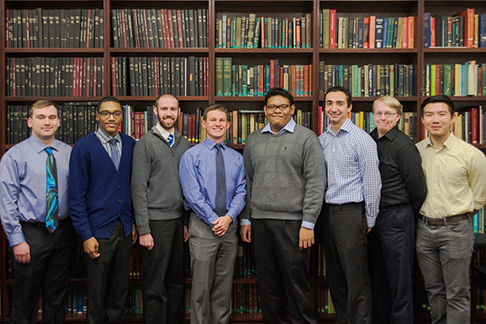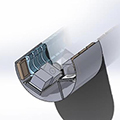AEM senior design team selected for NASA's RASC-AL design competition
An AEM Senior Design team has been selected to present in the final round of NASA’s RASC-AL Design Competition. RASC-AL is a full mission architecture engineering design competition at the university level. The 2017 competition focuses on the development of innovative architecture that helps to support NASA’s goal of improving our ability to work more effectively in micro-gravity.
Team members, Austin Meuchel, Bobby Nguyen, David Deng, Josh Hagood, Keegan Clay, Michael Schmidt, Seth Willing, and Vaughn Weirens have been working on designing an airlock for the airlock design theme of the competition since fall 2016. The objective of this category is to design an airlock system that can be incorporated or attached to a deep space habitat by 2021.

Group members, Austin Meuchel, Bobby Nguyen, David Deng, Josh Hagood, Keegan Clay, Michael Schmidt, Seth Willing, and Vaughn Wierens
The team was given the following requirements for their airlock design:
- Must have a minimum lifetime of fifteen years in a deep space environment
- Must support a maximum extravehicular activity rate (EVA) of one 2-person, 8 hour EVA every day for 3 days, every 30 days
- Includes incipient failure warning detection and alarm system
- Able to test EVA suit technologies before moon and mars surface missions
The groups Deep Space Airlock, “Janus” has a simple design plan: to take what is already known to work in airlock systems and to develop innovative solutions that make it possible for deep space missions. Bobby Nguyen explains this process by saying, “innovation does not mean to create something new, but to make something better."
The team chose to do the airlock theme because it is a less common category. “Designed airlocks, which are less operable in deep space are one of the key pieces of technology required to extend space exploration beyond low earth orbit. Compared to habitats or propulsion systems they are much less attractive and often overlooked, so it can be one of the more interesting and challenging problems because fewer people have already looked deeply into the design challenges," says David Deng.
Although the team members were eager to jump right into the design process, they quickly learned that they first needed to look at the overall scope of the project and plan accordingly. “Design is an iterative process, and we need to start with the big picture. Proper planning allows for us to meet objectives and then we can move on to being creative and finding innovations that seem feasible,” says Joshua Hagood.
Each member was given a specific tasks to work on with the ultimate goal of improving safety, comfort, and efficiency. “We all must have a role in order to function as a team,” says Joshua. Fellow team member, Austin Meuchel further explains, “Different people need to be dealt with differently. My biggest takeaway from the project was that I learned how to work with different personalities in a long-term engineering environment.”
The group started out by looking at existing solutions. From there, they began to focus on new technologies in order to develop innovative solutions to meet the requirements of the project. Much of these innovations revolved around the use of the Z-2 suit (NASA’s leading spacesuit design).
In order to incorporate the Z-2 suit into their design, it was necessary to decrease the amount of space required to store it. “The Z2 suit is a back entry suit, meaning it doesn’t come apart (easily) at the waist and astronauts have to enter from behind rather than underneath,” says David Deng. NASA’s current airlock, the Quest airlock stores their suits perpendicular to the axis of the airlock to take advantage of the waist entry. However, in order for the Janus airlock to do this it would be necessary to significantly increase the diameter of the design (which would not meet the design requirements). To avoid this, the team’s airlock design places the spacesuits parallel to the axis of the airlock.

Internal Configuration of the Janus
This internal configuration also supports rails that allow the suits to slide out for easier access. “This rack is hinged, and locks into place when astronauts prepare to don the suit. They can then remove the suit and don it in a prone position which is ideal for both rear and waste entry suits,” says Josh Hagood. Because this rack supports the weight of the astronauts, it works well in both low and micro-gravity environments.
Other innovations included improving the power efficiency of the aircraft with the implementation of lithium ion batteries, and enclosing an environmental control and life support system in the airlock as a redundancy measure.
The development of these innovations required extensive research in areas of aerospace design that the team members haven’t learned about in their previous classes. “This project forces students to do in-depth research in new technical subjects. Students learn how difficult it is to read research papers in new technical areas. They do a great job of learning how to gain an in depth understanding of the subject, and then to extend and apply the knowledge gained from the research to real world concepts,” says the team’s faculty advisor, John Weyrauch.
One of the main challenges they faced while conducting research was finding the information they needed in order to proceed with the project. “I realized that in research, I will have to find many answers myself, and I may have to be creative in order to give useful and reliable contributions to the team,” says Josh Hagood.
Josh, who researched spacesuits, found that it often took more than just a simple search to find necessary information. While researching the Z-2 Spacesuit (NASA’s leading spacesuit design), he realized that there was very little information that was readily available. He then turned to one of the teams NASA sponsors for assistance. Although the sponsor wasn’t able to provide him with specific information about the Z2 suit, he gave the team a document that provided them with specifications for the Extravehicular Mobility Unit (one of the two EVA spacesuits currently used by the International Space Station). With this information, the team was able to decide what was necessary for their mission. “It is important that we use our resources, especially when there is little accessible information to the general public,” says Josh.
Team member, Austin Meuchel had a similar experience while conducting research on power efficiency. In order to determine how the airlock would be powered once it was ready for use, Austin had to do comprehensive research on the current power capabilities that NASA had in place, which required both online research as well as correspondence with a designer at NASA. “I learned that it was ok to ask for help. There is almost certainly always someone who is more of an expert on the subject than you are, and they are usually more than happy to help,” says Austin.
The amount of time spent working on the project varied between each team member, however most members spent between 60 and 80 hours total on the project. The students had to learn to balance this with the demands of being a full time students. Proper planning, organization, and the delegation of tasks allowed them to do this in an effective way. These lifelong skills, as well as the knowledge and problem solving skills gained from research will greatly benefit them in the future.
Group members, Josh, Bobby, Seth, Vaughn, and Michael will be continuing to expand upon their work in preparation for their presentation, which will be held in Cocoa Beach, Florida from May 31-June 2. The department wishes the team the best of luck!
Last Modified: 2017-06-02 at 13:59:46 -- this is in International Standard Date and Time Notation


